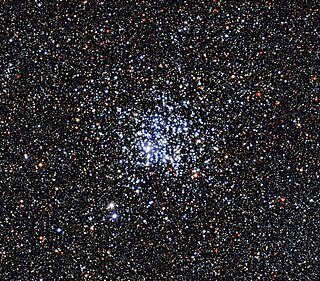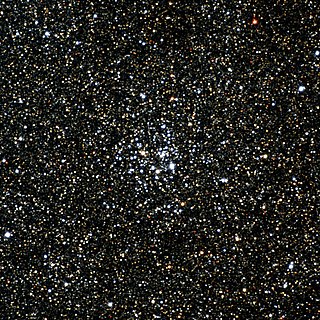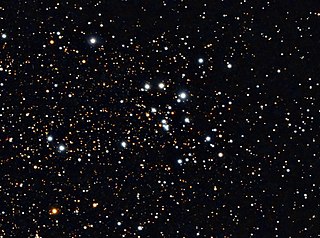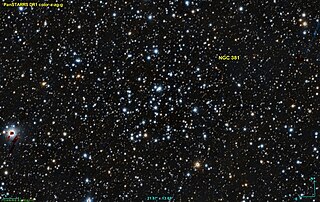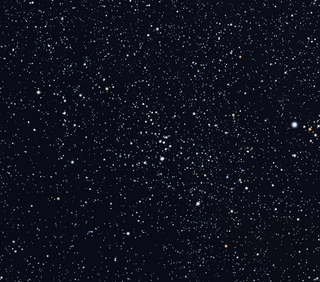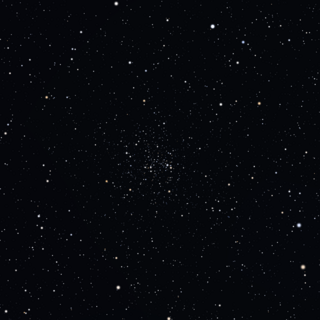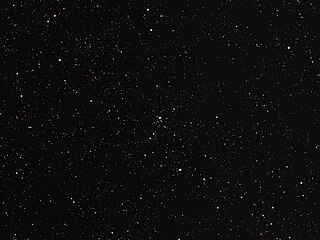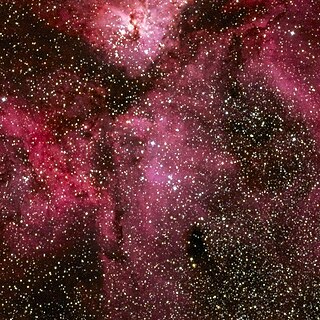
This is a list of open clusters located in the Milky Way. An open cluster is an association of up to a few thousand stars that all formed from the same giant molecular cloud. There are over 1,000 known open clusters in the Milky Way galaxy, but the actual total may be up to ten times higher. [1] The estimated half-lives of clusters, after which half the original cluster members will have been lost, range from 150 million to 800 million years, depending on the original density. [2]
| Cluster identifier | Constellation | Distance (parsecs) | Age (Myr) | Diameter | Apparent magnitude | Notes | ||
|---|---|---|---|---|---|---|---|---|
| Epoch J2000 | ||||||||
| R. A. | Dec. | |||||||
| Hyades | 04h 26.9m | +15° 52′ | Taurus | 47 | 625 | 330' | 0.5 | [3] |
| Coma Star Cluster | 12h 22.5m | +25° 51′ | Coma Berenices | 86 | 400-500 | 120' | 1.8 | [4] |
| Trapezium Cluster | 5h 35.4m | −05° 27′ | Orion | 412 | 0.3 | 0.783' | 4.0 | [5] |
| Messier 6, Butterfly Cluster | 17h 40.1m | −32° 13′ | Scorpius | 487 | 94 | 20' | 4.2 | [1] |
| Messier 7 | 17h 53.8m | −34° 47′ | Scorpius | 280 | 224 | 80' | 3.3 | [6] [7] |
| Messier 11, Wild Duck Cluster | 18h 51.1m | −06° 16′ | Scutum | 1,900 | 250 | 13' | 5.8 | [1] [7] [8] |
| Messier 16, Eagle Nebula | 18h 18.8m | −13° 49′ | Serpens | 1,800 | 1.3 | 6' | 6.0 | [1] |
| Messier 18 | 18h 20.0m | −17° 06′ | Sagittarius | 1,296 | 17 | 5' | 6.9 | [1] |
| Messier 21 | 18h 04.2m | −22° 29′ | Sagittarius | 1,205 | 12 | 14' | 5.9 | [1] |
| Messier 23 | 17h 57.0m | −18° 59′ | Sagittarius | 628 | 300 | 30' | 5.5 | [1] [7] |
| Messier 24 | 18h 17.0m | −18° 29′ | Sagittarius | 3,070 | 220 | 90' | 2.5 | [1] [7] |
| Messier 25 | 18h 31.7m | −19° 07′ | Sagittarius | 620 | 92 | 30' | 4.6 | [1] |
| Messier 26 | 18h 45.3m | −09° 23′ | Scutum | 1,600 | 85 | 7' | 8.0 | [1] |
| Messier 34 | 02h 42.1m | +42° 46′ | Perseus | 499 | 180 | 36' | 5.2 | [1] [7] |
| Messier 35 | 06h 09.1m | +24° 21′ | Gemini | 912 | 180 | 25' | 5.0 | [9] |
| Messier 36 | 05h 36.2m | +34° 08′ | Auriga | 1,330 | 25 | 10' | 6.0 | [1] |
| Messier 37 | 05h 52.3m | +32° 33′ | Auriga | 1,400 | 347 | 14' | 5.6 | [1] |
| Messier 38 | 05h 28.7m | +35° 51′ | Auriga | 1,400 | 316 | 20' | 6.4 | [1] |
| Messier 39 | 21h 31.8m | +48° 27′ | Cygnus | 311 | 280 | 30' | 4.6 | [1] [6] |
| Messier 41 | 06h 46.0m | −20° 46′ | Canis Major | 710 | 240 | 40' | 4.5 | [1] [7] |
| Messier 44, Beehive Cluster | 08h 40.4m | +19° 41′ | Cancer | 187 | 830 | 70' | 3.1 | [10] [11] |
| Messier 45, Pleiades | 03h 47.4m | +24° 07′ | Taurus | 136 | 125 | 120' | 1.2 | [12] |
| Messier 46 | 07h 41.7m | −14° 49′ | Puppis | 1,510 | 250 | 20' | 6.1 | [1] |
| Messier 47 | 07h 36.6m | −14° 30′ | Puppis | 490 | 73 | 25' | 4.4 | [1] |
| Messier 48 | 08h 13.7m | −05° 45′ | Hydra | 770 | 400 | 30' | 5.8 | [1] |
| Messier 50 | 07h 02.6m | −08° 23′ | Monoceros | 1,000 | 130 | 14' | 5.9 | [9] |
| Messier 52 | 23h 24.8m | +61° 35′ | Cassiopeia | 1,400 | 160 | 15 | 6.9 | [1] |
| Messier 67 | 08h 51.3m | +11° 48′ | Cancer | 908 | 4,000 | 25' | 6.9 | [1] [7] |
| Messier 93 | 07h 44.6m | −23° 52′ | Puppis | 1037 | 390 | 10' | 6.2 | [1] |
| Messier 103 | 01h 33.4m | +60° 39′ | Cassiopeia | 3,000 | 16 | 5' | 7.4 | [13] |
| IC 2602, Southern Pleiades | 10h 43.2m | −64° 24′ | Carina | 167 | 30 | 100' | 1.9 | [14] |
| IC 2391, Omicron Velorum Cluster | 08h 40.6m | −53° 02′ | Vela | 176 | 30 | 60' | 2.5 | [14] |
| NGC 2451 A | 07h 45.4m | −37° 58′ | Puppis | 189 | 50 | 45' | 2.8 | [6] [15] |
| Alpha Persei Cluster | 03h 26.0m | +49° 07′ | Perseus | 172 | 50 | 300' | 1.2 | [16] |
| Arp-Madore 2 | 07h 38.8m | −33° 51′ | Puppis | 8,870 | 5,000 | 1.3' | [17] | |
| Blanco 1 | 00h 04.3m | −29° 56′ | Sculptor | 253 | 100 | 90' | 4.5 | [14] |
| Hodge 301 | 05h 38.5m | −69° 04′ | Dorado | 51,400 | 25 | 0.5' | 11 | [18] [19] |
| Lambda Orionis Cluster | 05h 35m | +09° 56′ | Orion | 438 | 5 | 2.8 | [20] | |
| Pi Puppis Cluster | 07h 08m | −37° 10′ | Puppis | 319 | 50' | 2.1 | [21] | |
| Melotte 186 | 18h 01.1m | +02° 54′ | Ophiuchus | 200 | 100 | 240' | 3.0 | [22] |
| NGC 2070 | 05h 38.7m | −69° 06′ | Dorado | 48,500 | 1.5 | 3.5' | 7.25 | [23] [24] |
| NGC 2232 | 06h 26.4m | −04° 45′ | Monoceros | 325 | 53 | 45' | 3.9 | [1] [6] |
| IC 4756 | 18h 39.0m | −05° 27′ | Serpens | 330 | 500 | 40' | 4.6 | [1] [6] |
| NGC 2516, Southern Beehive Cluster | 07h 58.0m | −60° 48′ | Carina | 346 | 141 | 30' | 3.8 | [6] [7] |
| IC 4665 | 17h 46.3m | +05° 43′ | Ophiuchus | 352 | 43 | 70' | 4.2 | [1] |
| Trumpler 10 | 08h 47.8m | −42° 29′ | Vela | 365 | 35 | 14' | 4.6 | [1] [6] |
| NGC 6633 | 18h 27.7m | +06° 34′ | Ophiuchus | 375 | 660 | 20' | 4.6 | [25] |
| IC 348 | 03h 44.6m | +32° 10′ | Perseus | 385 | 44 | 7' | 7.3 | [1] |
| NGC 752 | 01h 57.7m | +37° 47′ | Andromeda | 400 | 1,700–2,000 | 75' | 5.7 | [26] |
| NGC 3532, Wishing Well Cluster | 11h 06.4m | −58° 40′ | Carina | 405 | 316 | 50' | 3.0 | [6] [7] |
| Collinder 121 | 07h 08m | −37° 10′ | Canis Major | 600 | 50' | 2.6 | [27] | |
| Collinder 140 | 07h 24.5m | −31° 51′ | Canis Major | 410 | 35 | 42' | 3.5 | [1] [6] |
| Collinder 261 | 12h 38.0m | −68° 22′ | Musca | 2,500 | 8,000 | 9' | 10.7 | [28] [29] |
| NGC 2547 | 08h 10.8m | −49° 18′ | Vela | 433 | 38 | 25' | 4.7 | [6] |
| NGC 6281 | 17h 04.7m | −37° 59′ | Scorpius | 479 | 220 | 8' | 5.4 | [1] |
| NGC 225 | 00h 43.6m | +61° 46′ | Cassiopeia | 657 | 130 | 12' | 7.0 | [1] |
| NGC 5662 | 14h 35.6m | −56° 37′ | Centaurus | 666 | 70 | 30' | 5.5 | [1] [7] |
| NGC 5460 | 14h 07.4m | −48° 20′ | Centaurus | 678 | 160 | 36' | 5.6 | [1] [7] |
| NGC 189 | 00h 39.7m | +61° 04′ | Cassiopeia | 752 | 10 | 3.7' | 8.8 | [1] |
| NGC 6025 | 16h 03.3m | −60° 26′ | Triangulum Australe | 756 | 130 | 14' | 5.1 | [1] [7] |
| IC 5146 | 21h 53.5m | +47° 16′ | Cygnus | 852 | 1 | 9' | 7.2 | [1] |
| NGC 2301 | 06h 51.75m | +00° 28′ | Monoceros | 858 | 165 | 12' | 6.0 | [30] |
| IC 4651 | 17h 24.8m | −49° 56′ | Ara | 888 | 1,900 | 10' | 6.9 | [1] [7] |
| NGC 6087, S Normae Cluster | 16h 18.8m | −57° 56′ | Norma | 891 | 70 | 14' | 5.4 | [1] [7] |
| NGC 3114 | 10h 02.7m | −60° 07′ | Carina | 911 | 124 | 36' | 4.2 | [1] |
| NGC 2509 | 08h 00.7m | −19° 04′ | Puppis | 912 | Uncertain [31] | 10' | 9.3 | [32] |
| NGC 2264 | 06h 41.0m | +09° 53′ | Monoceros | 913 | 1.5 | 40' | 3.9 | [33] |
| NGC 1502 | 04h 07.8m | +62° 20′ | Camelopardalis | 1,000 | 10 | 8' | 5.7 | [1] |
| Berkeley 59 | 00h 04.0m | +68° 35′ | Cepheus | 1,000 | 2 | 180' | [34] | |
| NGC 2169 | 06h 08.4m | +13° 58′ | Orion | 1,052 | 12 | 5' | 5.9 | [1] |
| NGC 6242 | 16h 55.6m | −39° 28′ | Scorpius | 1,131 | 50 | 9' | 6.4 | [1] [7] |
| NGC 381 | 01h 08.3m | +61° 35′ | Cassiopeia | 1,148 | 320 | 7' | 9.3 | [1] |
| NGC 6204 | 16h 46.1m | −47° 01′ | Ara | 1,200 | 79 | 6' | 8.2 | [1] |
| NGC 6231 | 16h 54.1m | −41° 50′ | Scorpius | 1,243 | 6 | 14' | 2.6 | [1] [7] |
| NGC 2439 | 07h 40.8m | −31° 41′ | Puppis | 1,300 | 25 | 9' | 6.9 | [1] [7] |
| NGC 6067 | 16h 13.2m | −54° 13′ | Norma | 1,417 | 170 | 14' | 5.6 | [1] [7] |
| NGC 2362, Tau Canis Majoris Cluster | 07h 18.6m | −24° 59′ | Canis Major | 1,480 | 4–5 | 5' | 4.1 | [35] |
| NGC 6756 | 19h 08.7m | +04° 42′ | Aquila | 1,507 | 62 | 4' | 4.5 | [1] |
| NGC 6031 | 16h 07.9m | −54° 03′ | Norma | 1,510 | 117 | 3' | 8.5 | [1] [36] |
| NGC 2175 | 06h 09.7m | +20° 29′ | Orion | 1,627 | 8.9 | 5' | 6.8 | [1] |
| NGC 188 | 00h 48.4m | +85° 15′ | Cepheus | 1,660 | 6,600 | 17' | 8.1 | [7] [37] |
| NGC 2244 | 06h 31.9m | +04° 56′ | Monoceros | 1,660 | 1.9 | 30' | 4.8 | [1] |
| NGC 129 | 00h 30.0m | +60° 13′ | Cassiopeia | 1,670 | 76 | 21′ | 6.5 | [38] |
| NGC 2360, Caroline's Cluster | 07h 17.7m | −15° 38′ | Canis Major | 1,887 | 1,000 | 13' | 7.2 | [1] [7] |
| NGC 6834 | 19h 52.2m | +29° 25′ | Cygnus | 1,930 | 76 | 5' | 7.8 | [1] [36] |
| NGC 659 | 01h 44.4m | +60° 40′ | Cassiopeia | 1,938 | 35 | 5' | 7.9 | [1] |
| NGC 4755, Jewel Box | 12h 53.6m | −60° 22′ | Crux | 1,976 | 14 | 10' | 4.2 | [1] [7] |
| NGC 6200 | 16h 44.1m | −47° 28′ | Ara | 2,056 | 8.5 | 12' | 7.4 | [39] |
| NGC 869 | 02h 19.1m | +57° 09′ | Perseus | 2,079 | 12 | 18' | 3.7 | [1] |
| NGC 637 | 01h 43.0m | +64° 02′ | Cassiopeia | 2,160 | 10 | 4.2' | 8.2 | [1] |
| NGC 2355 | 07h 17.0m | +13° 47′ | Gemini | 2,200 | 955 | 5' | 9.7 | [1] [7] |
| NGC 2129 | 06h 01.1m | +23° 19′ | Gemini | 2,200 | 10 | 5' | 6.7 | [1] [40] |
| NGC 663 | 01h 46.1m | +61° 14′ | Cassiopeia | 2,420 | 25 | 14' | 7.1 | [1] |
| NGC 457 | 01h 19.1m | +58° 17′ | Cassiopeia | 2,429 | 21 | 20' | 6.4 | [41] |
| NGC 2204 | 06h 15.5m | −18° 40′ | Canis Major | 2,629 | 787 | 13' | 8.6 | [1] |
| NGC 884 | 02h 22.0m | +57° 08′ | Perseus | 2,940 | 14 | 18' | 3.8 | [1] [7] |
| NGC 1931 | 05h 31.0m | +34° 15′ | Auriga | 3,086 | 10 | 3' | 10.1 | [1] |
| NGC 1980 | 5h 25.43m | −05° 54′ | Orion | 550 | 4.7 | 14' | 2.5 | [42] |
| NGC 2158 | 06h 07.4m | +24° 06′ | Gemini | 5,071 | 1,054 | 5' | 8.6 | [1] |
| Teutsch 2 | 05h 41.4m | +39° 14′ | Auriga | 5,700 | 900 | 2' | 11 | [43] |
| NGC 6791 | 19h 20.9m | +37° 46′ | Lyra | 5,853 | 8,900 | 16' | 9.5 | [1] [7] |
| NGC 3293 | 10h 35.8m | −58° 13′ | Carina | 2,750 | 8 | 8' | 4.7 | |
| NGC 3766, Pearl Cluster | 11h 36.2m | −61° 37′ | Centaurus | 1745 | 14 | 12' | 5.3 | |
| NGC 7419 | 22h 54.3m | +60° 48.9′ | Cepheus | 2,800 | 2' | 13 | ||
| NGC 7789, White Rose Cluster | 23h 57.4m | +56° 43′ | Cassiopeia | 2,337 | 1,700 | 16' | 6.7 | [44] |
| Gaia 1 | 06h 45.9m | −16° 45′ | Canis Major | 4,600 | 6,300 | 13' | 8.3 | |
| Ru 7 | 06h 58.9m | −13° 15′ | Canis Major | [ citation needed ] | ||||
